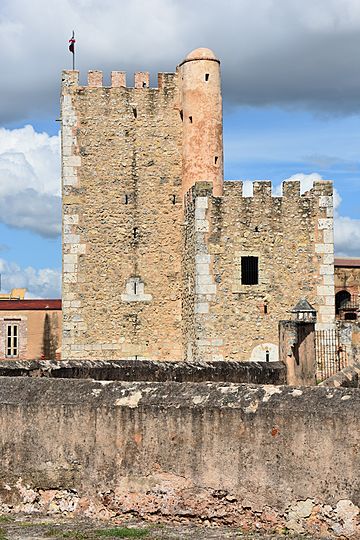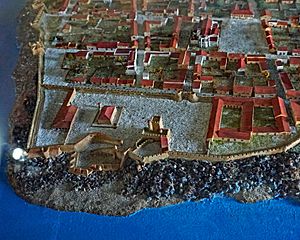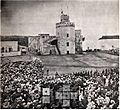Fortaleza Ozama facts for kids
| UNESCO World Heritage Site | |
|---|---|

Tower of Ozama Fortress
|
|
| Location | Santo Domingo, Dominican Republic |
| Part of | Colonial City of Santo Domingo |
| Criteria | Cultural: (ii), (iv), (vi) |
| Inscription | 1990 (14th Session) |
The Ozama Fortress (called Fortaleza Ozama in Spanish) is a very old and important building in Santo Domingo, Dominican Republic. It's known as the oldest military building made by Europeans in the Americas. The Spanish started building it between 1502 and 1508. It stands at the entrance to Santo Domingo's Colonial City, looking over the Ozama River. The fortress is named after this river.
This castle is also called "La Fortaleza" or "The Fortress." UNESCO has named it a World Heritage Site, along with other historic places in the Ciudad Colonial. The Ozama Fortress is a key part of the Colonial City of Santo Domingo. Experts believe it took from 1502 to 1508 to build, and Governor Nicolás Ovando started the work. In the 1500s, its 18-meter-high tower was the tallest European-built structure in the Americas.
The fortress is built like a stone castle and still looks much like it did hundreds of years ago. Inside, there are tunnels and dungeons where prisoners were kept. Even Christopher Columbus, a very famous explorer, was once held prisoner in the Ozama Fortress.
Contents
History of the Fortress
The Ozama Fortress was built to protect the city of Santo Domingo. Its main goal was to defend against attacks from the sea, especially from English, French, and Dutch pirates and other groups trying to take over the city.
Building the Fortress
The builders used strong coral stones taken from the sea. Many Black and Taino slaves worked hard to construct the fortress. Nicolás de Ovando, who founded Santo Domingo, personally chose the spot for the fortress. It was finished around 1505. The Spanish considered it a very important base for their exploration of the island.
The main architect was a Spanish man named Gómez Garcia de Varela. The construction began with the tall central tower, then the platforms for cannons, and finally the main defensive fort.
Famous Attacks and Changes
In 1586, the famous pirate Sir Francis Drake captured the Fortaleza. The main entrance gate on Calle Damas was first built in 1608. It was known as the Prevention Gate. Later, in 1787, this gate was replaced by the one you see today, called the Carlos III gate.
Many important people were held prisoner in the fortress over the years. These included pirates and even former presidents like Jacinto Peynado and Horacio Vásquez. In 1937, under the leader Rafael Trujillo, the outside walls were made stronger with battlements (the tooth-like tops of castle walls).
Becoming a Public Place
In 1965, the Ozama Fortress stopped being a prison. It became a public building. In April 1965, a conflict known as the Patriotic War began. A group of soldiers and citizens elected Colonel Francisco Caamano as president. During his time as president, Colonel Francisco Alberto Caamaño Deño made the Ozama Fortress a public place by law. It was renamed Plaza de la Constitución. You can still see bullet holes in the doors from the fighting during the Dominican Civil War in 1965.
What the Fortress Looks Like
The Fortaleza is located at the end of Las Damas Street. It's named after the Ozama River, which flows nearby.
In front of the building, there is a statue of Gonzalo Fernández de Oviedo y Valdés. He was the governor of the fortress from 1533 to 1557. He also wrote an important book about the history of the Americas. The statue came from Salamanca, Spain, in 1977. It was made by the artist Joaquín Vaquero Turcio.
The central tower of the fortress is 18 meters (about 59 feet) tall. Its walls are 2 meters (about 6.5 feet) thick. The fortified walls around the building are 3 meters (almost 10 feet) thick. However, the walls on the river side are a bit thinner, about 1 meter (3.2 feet) thick. The cement used to hold the stone walls together was a mix of gypsum, clay, lime, and even animal blood!
Notable People Held Here
Many important figures in Dominican history were held at the Ozama Fortress. These included:
- Christopher Columbus (explorer)
- Juan Pablo Duarte (founder of the Dominican Republic)
- Francisco del Rosario Sánchez (a former president of the Dominican Republic)
- Matías Ramón Mella (a revolutionary and military general)
- María Trinidad Sánchez (a Dominican independence fighter)
- Antonio Duvergé (a military general)
- Jacinto Peynado (former president)
- Horacio Vásquez (former president)
- Alejandro Woss y Gil (former president)
- Rafael Alburquerque (former vice president)
- Fabio Fiallo (a famous writer)
Gallery
-
Statue of Gonzalo Fernández de Oviedo y Valdés
See also
 In Spanish: Fortaleza Ozama para niños
In Spanish: Fortaleza Ozama para niños
- List of colonial buildings in Santo Domingo
- Colonial City of Santo Domingo
- List of oldest buildings in the Americas















